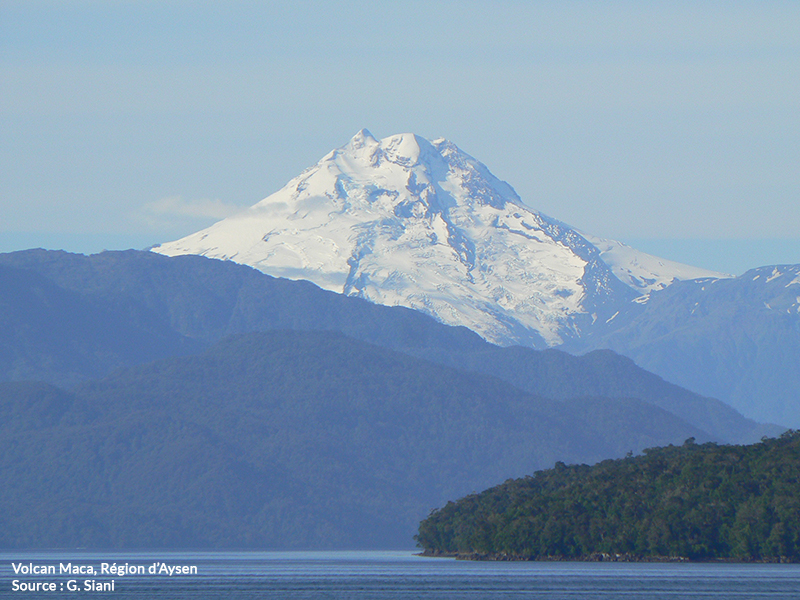South-Est Pacific Ocean Reservoir Age – Quantification of C14 ages for the South-East Pacific ocean reservoir
Funding
INSU-LEFE-IMAGO 2016 (2016-2018)
Project leader
G. Siani (GEOPS)
Collaborations
G. Delpech (GEOPS), S. Duchamp-Alphonse (GEOPS), E. Michel (LSCE)
Project / Programme
Action “Interactions Multiples dans l’Atmosphère, la Glace et l’Océan” (IMAGO) [Multiple Interactions in the Atmospheres, Ice and Ocean]
The Southern Ocean (SO) plays a fundamental role in the global climatic system. In fact, a key element in thermohaline circulation is the return route of water masses from the ocean depths to the surface via upwelling. This process is largely controlled by latitudinal position and the intensity of winds from the west (westerlies). In recent years the study of the SO and these upwelling has become a priority in order to obtain a better understanding of the climatic system because, in particular, they control the quantity of heat and carbon transferred from the deepest ocean reservoir to the surface ocean and the atmosphere. The development of accurate age models for the marine and continental archives is therefore essential for better understanding the mechanisms, the temporal frequency, and the geographical repercussions which govern ocean-climate interactions. An essential prerequisite for establishing robust age models in the marine context, is the quantification of C14 ages for the surface ocean reservoir (Rsurf) which is principally linked to the reduction of C14 in the water column and to the mixing of different water masses, in other words ocean circulation. Regional stratigraphic markers, such as volcanic tephras retrieved from marine cores and terrestrial archives, are used to reconstruct past (Rsurf). The project’s scientific goal depends on the detailed study of the marine and continental tephrachronology using sedimentary series sampled along a N-S transect off the southern coast of Chile (Figure 1; 40°S and 46°S). Using laser ablation in conjunction with LA-ICP-MS-HR analysis allows more accurate identification of the volcanic sources and thus ensures that robust correlations are made between marine and continental tephras. This allows an independent estimation of Rsurf variations and makes it easier to establish accurate age models of marine climatic records on the South-East Pacific rim. This data is necessary in order to constrain: (i) the ventilation time of intermediate and deep ocean water ventilation and the depth at which the upwelling cell ascends within the SO; (ii) the climatic mechanisms controlling ocean circulation in this region and, at a larger scale, the carbon cycle since the last glacial period.
This project is being undertaken within the framework of a PhD thesis by Consuelo Martinez Fontaine (Estimation of C14 ages of the surface and deep ocean reservoir in the South-eastern Pacific sector of the Southern Ocean since the last glacial period)
 Figure 1: Map of South America and the South-eastern Pacific Ocean representing: white arrows, the principal ocean currents (ACC: Arctic Circumpolar Current; CHC: Cape Horn Current; PCC: Peru-Chile Current; AAIW: Antarctic Intermediate Waters; CPDW: Pacific Deep Water); red arrows, the westerly winds; SVZ: South Volcanic Zone; AVZ: Austral Volcanic Zone. The locations of terrestrial sites are indicated by white dots. Marine core sites are indicated by yellow stars apart from reference core MD07-3088 (4, red dot). Also included is a salinity/latitude/depth section representing the positions of the cores as a function of their bathymetry and the main ocean water masses.
Figure 1: Map of South America and the South-eastern Pacific Ocean representing: white arrows, the principal ocean currents (ACC: Arctic Circumpolar Current; CHC: Cape Horn Current; PCC: Peru-Chile Current; AAIW: Antarctic Intermediate Waters; CPDW: Pacific Deep Water); red arrows, the westerly winds; SVZ: South Volcanic Zone; AVZ: Austral Volcanic Zone. The locations of terrestrial sites are indicated by white dots. Marine core sites are indicated by yellow stars apart from reference core MD07-3088 (4, red dot). Also included is a salinity/latitude/depth section representing the positions of the cores as a function of their bathymetry and the main ocean water masses.

